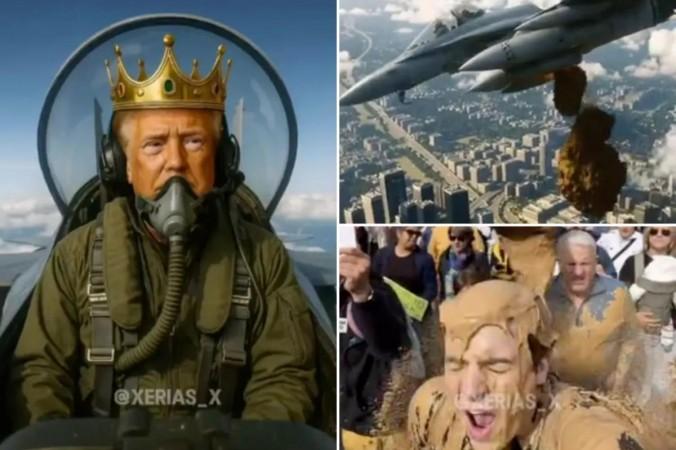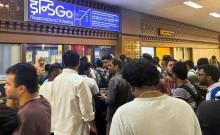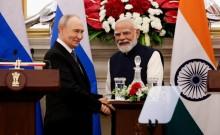
In a striking move, former U.S. President Donald Trump has released an AI-generated video on his Truth Social platform, depicting himself as a "King Trump" fighter pilot. The video shows Trump wearing a crown and piloting a jet over a city resembling Times Square, where he drops brown sludge on protesters. This video coincides with the "No Kings" demonstrations, a series of nationwide protests against Trump's administration. The protests, held in all 50 states, have drawn thousands of participants who are voicing their concerns over perceived authoritarianism and threats to democracy under Trump's leadership.
The protests have been marked by creative expressions, with demonstrators donning costumes ranging from Cookie Monster to dinosaurs, symbolically mocking the perceived absurdity of power. Protesters have cited various grievances, including immigration raids, troop deployments in U.S. cities, and cuts to federal healthcare and social programs. The demonstrations have also coincided with a federal government shutdown, resulting from a funding standoff between the White House and Congress, further fueling public frustration.
The official White House X account added to the controversy by sharing an image of Trump and Vance wearing crowns, juxtaposed with Democratic leaders Hakeem Jeffries and Chuck Schumer in sombreros. The caption, "We're built different. Have a good night, everyone. ," has sparked further debate and criticism. This response from the White House has been perceived by many as an attempt to trivialize the protests and dismiss the concerns of the demonstrators.
Protests and Political Tensions
The "No Kings" protests are not an isolated event. Earlier this year, similar demonstrations were held against Elon Musk's Department of Government Efficiency (DOGE) job cuts and Trump's military parade, drawing thousands of participants. Organizers of the current protests have described them as a unifying force for the opposition, bringing together diverse groups with a common goal of resisting authoritarianism. The protests have been largely peaceful, with police reporting no major incidents or arrests in many large cities.
We’re built different.
— The White House (@WhiteHouse) October 19, 2025
Have a good night, everyone. ? pic.twitter.com/4WBVxq2Cfe
However, the presence of federal immigration agents and National Guard troops in cities like Portland and Chicago has raised concerns about the militarization of local law enforcement. Critics have accused the White House of using these operations to provoke unrest that might trigger the president's invocation of the Insurrection Act. Ezra Levin, co-founder of Indivisible, commented, "They're clearly scared of peaceful opposition," reflecting the concerns of many protesters who fear that their rights are being undermined.
Local issues have also been highlighted during the protests. In Atlanta, activists have drawn attention to the treatment of homeless residents ahead of next year's World Cup. A representative from Play Fair ATL, a coalition of rights groups, urged city officials to honor their pledge not to forcibly remove unhoused people from downtown areas under pressure from FIFA and the Trump administration. These local concerns have added another layer to the national discourse on democracy and governance.
Historical Context and Technological Influence
The "No Kings" demonstrations echo historical events where citizens have rallied against perceived authoritarianism. The Vietnam War protests in the 1960s and 1970s saw millions of Americans demand an end to U.S. involvement in the conflict. Similarly, the civil rights movement of the 1960s was marked by widespread protests against racial segregation and discrimination. In both cases, the protests were driven by a desire for change and a belief in the power of collective action.
The use of AI-generated content in political discourse is a relatively new phenomenon, but it has already proven to be a powerful tool for shaping public perception. Trump's video is just the latest example of how technology can be used to create provocative and controversial imagery that captures the public's attention. This technological influence has added a new dimension to the political landscape, raising questions about the role of digital media in shaping public opinion.
As the protests continue, the situation remains fluid, with the potential for further developments. The "No Kings" demonstrations have already succeeded in drawing attention to the issues at hand, sparking a national conversation about the state of democracy in the United States. Whether this will lead to meaningful change is uncertain, but the protests have undoubtedly made their mark on the political landscape.
The "No Kings" protests and the accompanying AI-generated video of Trump as "King Trump" have highlighted the deep divisions in American society. They have underscored the power of technology to influence public opinion and the importance of collective action in the face of perceived authoritarianism. As the nation grapples with these challenges, the voices of the protesters serve as a reminder of the enduring struggle for democracy and justice.















